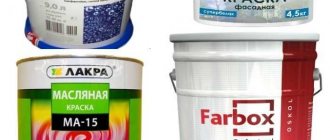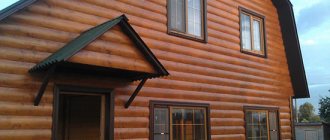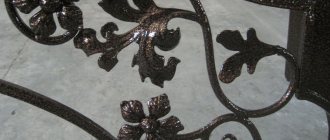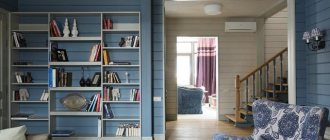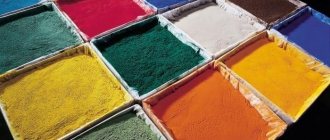Wooden doors
Wooden doors look aesthetically pleasing and elegant. There are many opportunities to buy blanks for painting or varnishing. It's cheap and practical. You can paint the old product in the desired tone that matches the interior. Many people wonder what is used to cover solid wood doors. There are many upgrade options. The only thing that is necessary is to adhere to the technology of preparing the canvas and painting.
Solid pine surface covered with enamel
Features of painting door panels
It often happens that old doorways have a good frame and panel, but have lost their original luster. An affordable, simple method of updating is coating with coloring materials. Any person can handle this kind of work. It is enough to know the properties of the paint and varnish materials from which the doors are made. Attention is paid to compliance with the technology of painting structures:
- Paneled canvases. Before painting, they are disassembled into elements, since the number of joints leads to wear and requires updating.
- Solid wood: heavy structures that convey the natural structure of wood. To update, use varnish or paint for such wood-look doors.
With varnish applied
- MDF. Painting the structure is simple, but before doing this, carefully prepare the surface.
Arsenal of available coloring products
Among the paints available today that allow you to both paint a door while maintaining the texture and completely disguise it, the following are the most commonly used:
In this case, paint for doors that have been in use for a long time and have been painted more than once must have one of the following bases:
The first option has good moisture-repellent ability and is resistant to temperature changes and exposure to sunlight. Therefore, they are often used when updating door panels in baths, showers, saunas and other damp rooms. The second type of paint, on the contrary, is water-based and spreads well over the surface, is safer and can be used indoors with virtually no restrictions.
Source
Choosing the shade of interior door designs
The range of paints makes it possible to implement different design solutions, so the question of how to cover the surface does not arise. Three color trends are visible in the design: delicate, light shades; bright shades of yellow, red; dark shades. When choosing a color, adhere to the following principles:
Shades of colors
- Shades of chocolate and cherry add luxury and sophistication.
- In the bedroom and children's room, choose light colors that create coziness and comfort.
- Solid wood doors are suitable for log houses.
- In a room with antique furniture, artificially aged ones look great.
- The color of the door frame is made darker (lighter) than the walls.
Making an antique effect
Antique doors highlight the design solutions in the room. To update the interior of the house in this way, an “antique” wooden door is created. Several technologies are used for this:
- Brushing is a simple technique that is used by many craftsmen. The work is done with an iron brush, with which the top layer of wood is removed (until the annual rings appear). But this technique of giving the door an antique look requires a large amount of varnish;
When brushing, the top layer is removed with a wire brush. - patina - “patina” is a special paint that is often used to create the effect in question. The technology for applying the mixture consists of choosing the desired color and applying 1 main layer, which is subsequently covered with paints or varnishes, but of a lighter shade. If the surface is dry, fine-grained sandpaper is used to make it look antique. The bottom layer, which appears through the top, creates the effect of numerous paintings. “Natural scratches” can be seen on the canvas;
Patching gives the wood the effect of multiple paintings - aging with wax - to perform this technology, you will need to follow a certain sequence: applying wax - painting in a lighter tone. After complete drying, the paraffin is removed. A spatula is used for this. Then the base is sanded. Varnish or stain is applied. The door is treated with wax. It is this technology that allows you to create a “antique” appearance that is as close to the truth as possible.
Tags: door, wooden, cover, pine
« Previous entry
Selection of painting material
High-quality paint does not come cheap. Sometimes stores offer discounts on quality paints as they approach their expiration date. If painting is carried out immediately after purchasing the paint and varnish material, then this option will save money without reducing quality.
When thinking about what solid wood doors are coated with, you will need knowledge about paint and varnish materials. The range of paints is divided into: transparent, opaque. The first include impregnations, varnishes, and glazes. When the canvas is treated with a transparent coating, the natural color and wood pattern are emphasized. For solid wood canvases, varnish is often used. It protects the surface from moisture and various influences. Varnishes come in clear and tinted varieties.
Important. When purchasing varnish, pay attention to the drying speed. It is better to take quick-drying paintwork. It does not spread on the surface and is also harmless.
Opaque coatings include alkyd and oil-based coloring materials that have their own characteristics. Most often used:
Paint for doorways
- Nitro paint. It has aesthetic properties, a wide color palette that is superior to other types of paints. It has strength and wear resistance. But it is harmful to health, its fumes are toxic.
- Acrylic. Suitable for use in rooms. When painting, it applies well and there is no toxic smell. The disadvantages of paint include low strength and high cost. To increase durability, acrylic varnish is applied to the paint.
- Alkyd enamel. It is affordable, has a wide range of shades, and forms a durable coating. This paint is suitable for wooden doors, it is wear-resistant, economical, and dries quickly. Significant disadvantage: the unpleasant odor persists for 2 days. This type of paint is not used where allergy sufferers or children live.
Dyeing technology
If you are painting a new canvas, you should protect it from swelling. First lay it on a flat surface and sand it with sandpaper or a sander. Then the panel is primed, the recesses and smooth areas are processed. After the surface has dried, secondary treatment is carried out.
Rice. 8. Directions for painting the canvas
An old house door needs to be painted with high quality so that there are no stains or smudges on its surface. It is unlikely that you need to buy a spray bottle to paint one or two canvases, so you can use a paneled brush or roller.
After you have chosen what you can use to paint a wooden door, you should familiarize yourself with some of the nuances of the work:
Rice. 9. Sequence of web processing
Painting with alkyd enamel
To coat doors with alkyd enamel, the following steps should be followed:
Rice. 10. Alkyd enamel for treating wood surfaces
Stain treatment
When choosing a stain, no primer is used. The product penetrates into the deep layers of pine or oak wood, coloring its fibers and increasing its protective properties. There are several ways to apply the composition: rubbing, spraying, simple application and staining with a brush. Usually a simple application is used.
Rice. 11. Processing the canvas with stain
Since the stain will adhere better to a damp canvas, it needs to be slightly moistened. First, coloring is carried out along the fibers, and then across them. We perform the next layer in the direction of the fibers. We process the panel with jambs from below so as not to disturb the design of the structure.
After the water-based stain has been applied, the surface should be sanded using sandpaper (due to raised fibers), remove dust and apply the next layer of coating. If an alcohol stain is used, the fibers will not lift and no sanding is required. But aqueous formulations do not have an unpleasant odor or toxicity.
Oil or wax impregnations
There are nuances to processing canvas with oil impregnation. First, the Pinotex composition is mixed well. If applied incorrectly, darkened areas and streaks may appear. For work, use a brush, sprayer, roller or foam sponge. Depending on the porosity of the material, the number of layers will be calculated.
Rice. 12. Application of wax impregnation
First, take a little composition, distributing it evenly across the width of the panel. Then the impregnation is rolled out with a roller or rubbed with a brush without sagging. Drying time is 8-12 hours. No later than a day later, another layer is applied.
Wood imitation
To ensure that you paint interior wood doors with your own hands correctly, follow the instructions:
The wood structure can be created on veneered material by treating the fibers with a special brush (an antique effect is obtained). Then you need to apply one or more paint coatings to the surface and sand it.
How to paint laminated doors
Compared to doors made of natural wood, laminated products look aesthetically pleasing, are easy to use and are affordable. To process laminated doors you will need a roller or brush, wood putty with a spatula, sandpaper, rags, solvent and special enamel.
The surface is completely sanded, cleaned of dust with a rag and puttyed with a thin layer. After the putty has dried, it is treated with sandpaper, applied a second time and sanded again after drying. Before painting, the composition is diluted with a solvent. The paint is applied carefully, paying attention to hard-to-reach areas. After 3 layers, the result is secured with varnish.
Rice. 13. Varnishing wood surface
If there are no defects, the laminated coating can be renewed. A tinted varnish or stain is suitable, which is applied after sanding and tinting.
Preparatory work before painting
To cover the door with paint and varnish, you need to carry out some preparatory work. First of all, prepare the tool:
- brush;
- paint container;
- rags;
- gloves;
- scotch;
- sandpaper;
- 4 stools;
- putty knife.
Be sure to prepare paint and varnish materials.
Painting tools
The next step is preparing the canvas. It is removed from the canopies and placed horizontally on stools. If the chosen paint has a pungent, unpleasant odor, then the work should be done outside. Remove the fittings. Fixed elements are wrapped in paper and tape. The lock is closed with masking tape. To properly coat the surface, prepare it:
Removing old coating
- Remove the old paint coating and primer using a grinding machine, sandpaper, or stripping solution.
- Pre-grinding is performed, which helps remove scratches and paint.
- Remove dust and dirt.
- Fill imperfections and cracks in wood.
- After drying, the canvas is puttied with medium-grain sandpaper and then with fine-grain sandpaper.
Attention. Darkened wood is lightened with a mixture of chlorine bleach and water (3 to 1).
Video description
How to disassemble the paneled fabric, watch the video:
- grooves and tenons are cleaned of old glue and putty, the remains are sucked out with a vacuum cleaner;
- if necessary, remove paint and polish each part - it’s easier to do this separately than on the whole canvas;
- insert the panels into place, lubricating all locking joints with wood glue;
- the assembled canvas is compressed with clamps and left until the glue dries;
- insert dowels into the holes.
Assembly of paneled fabric Source mdveri56.rf
Scheme, procedure for coating a door with paintwork
The painting material is applied to the doors according to a specific pattern. The panel surface is painted in 3 stages. It is better to use a roller. It ensures uniform application and does not leave streaks. Start painting from the top from the corner of the door, across from left to right. Then, after drying, apply a second layer lengthwise, and a third layer crosswise.
The paneled door is painted with a brush, starting from the recesses. Make sure that no excess paint remains. Afterwards, the door is painted with a roller in accordance with the painting scheme for the panel surface. For rich color, paint in 3 layers.
Before varnishing doors, take into account the number of layers. Quality and appearance depend on this. Most often apply 3 times. Each layer is applied after the previous one has dried. The number of layers can be found on the varnish jar itself - information is provided by the manufacturer.
The varnish is applied to the wooden door with a large brush. If there are patterns, then use brushes of different sizes. To ensure that the varnished surface is smooth, painting is carried out on a flat surface with the door in a horizontal position.
To varnish, the canvas is placed in a horizontal position.
The first (base) layer is made with diluted (water, solvent) varnish along the length of the wood structure. You cannot stop the process, as dark spots remain. The next layer is applied crosswise, after drying and treating the surface with fine sandpaper. Varnishing of wooden doors is carried out until a smooth surface is formed.
Attention! If a drop of varnish gets on the surface and has time to dry, it is better to leave it as is. Otherwise, you can ruin the appearance.
How to treat wooden doors in a bathhouse
As mentioned above, bath doors are exposed to the strongest effects of humidity and temperature changes. And if they are not protected from such negative impacts, even the highest quality products after a year of operation will turn into unusable trash with large gaps and cracks.
Therefore, such doors must be treated with a special compound, which is called varnish for baths and saunas. This is a transparent varnish through which the texture of the wood is visible. It is made on an acrylic base, it is water-soluble, dries quickly, and has virtually no foreign odor. After drying, the bath door smells like wood.
Apply varnish only to a well-prepared surface. It must be dry and clean, and must be treated with a deep-penetrating antiseptic composition, for example, NTOMID 200, which is specially produced for rooms with high humidity and strong temperature changes. The antiseptic is applied in two or three layers, and after drying it is treated with varnish. It is applied only at temperatures above +5C in 1-3 layers, each of which must be dried naturally before applying the next one.
Painting pine canvas
The advantage of inexpensive pine is the pleasant smell of pine needles, which brings peace to the house and promotes good sleep. Pine is classified as a wood that is susceptible to environmental influences. Pine will become durable and wear-resistant if it is painted with the chosen paint coating.
Not all interior designers are willing to use pine doors - they have a lot of knots. This deficiency can be corrected with the help of stain, giving a noble shade.
Before painting a pine door, it is puttied and sanded. Resin stains are removed, the pine door leaf is sanded. To paint pine doors you need to do the following:
- Any pine door is pre-treated with sandpaper - sanded.
- The surface of the pine canvas is cleaned of dust.
- Pine doors are primed, which promotes uniform application of paint and protects the wood from rotting. To improve antiseptic protection, special impregnation is used.
- Next, a layer of stain of the required shade is applied to the pine door using a roller. Opaque paints are suitable for completely coloring the texture.
- The pine door is varnished.
When coating solid wood doors with paint and varnish, do not save time and do not shorten work processes. This results in an unattractive appearance and the appearance of defects on the surface of the canvas. Therefore, carrying out the main stages of painting from stripping to polishing is an important aspect of it.
How to paint pine doors correctly:
Voted over 257 times, average rating 4.6
Comments
Unfortunately, there are no comments or reviews yet, but you can leave your...
Add a comment Cancel reply
We recommend reading
Wooden doors How to properly repair wooden balcony doors? Wooden balcony doors are not popular because they...
Wooden doors Key criteria for choosing carved wooden doors Despite technical development, the abundance of synthetic materials, ...
Wooden doors How to strengthen a wooden swing entrance door: strengthening options The main function of the entrance door is to protect the room from...
Wooden doors Technology for making paneled doors with your own hands Paneled doors are becoming popular. Make them at home...
Method of protection
To prevent moisture from damaging the door, you need to prevent it from getting inside. For this purpose, the door is painted. During polymerization, the layer of dye forms a protective film. For best protection, apply two coats of paint. Now moisture will not penetrate inside.
But the process of moisture penetration will resume when the protective layer of paint or varnish cracks. And this happens quite quickly, because the doors experience dynamic load during operation: in other words, they are opened and closed several times a day and not always lightly.
Many manufacturers are trying to use elastic coatings. They change their geometry along with changes that occur under dynamic loads. In addition to oil and varnish coatings, oil processing of products began to be used. This method of moisture protection works as follows:
- the oil penetrates into the wood, closes its pores, making it impossible for moisture to enter them;
- in the connections of individual parts, a single solid structure is formed from a polymerized oil coating. The joints are filled, all existing cracks are closed.
Required Tools
Before you begin painting the door, you should prepare the necessary tools and materials. The list is like this:
- supports for laying the canvas (trunks, stools, etc.);
- painting tray and roller (spray gun);
- moderately sharp spatula;
- rags, sponge or rags;
- a set of sandpaper of different grain sizes;
- masking tape;
- set of brushes;
- vacuum cleaner;
- screwdriver or set of screwdrivers;
- primer;
- solvent;
- paint and varnish products (paint, varnish, impregnation, etc.);
- putty;
- protective gloves.
It is best to carry out painting work outside, rather than in a residential apartment, to ensure the safety of its residents.
How to use stain correctly?
Painting a door with stain
To ensure that the wood does not absorb excess moisture and the paint applies evenly, the prepared canvas needs to be slightly moistened. All horizontal surfaces are treated with stain along the grain and then across it. The finishing layer is also applied in the longitudinal direction.
The jambs and parts that have not been dismantled begin to be covered from below so that the drops do not touch the still untouched areas. This sequence of actions is followed if the finishing layer is an opaque material. When the surface treated with stain absorbs moisture, the wood fibers straighten, which is why you will need to sand the canvas with zero sandpaper and repeat the procedure.
It is also worth noting that after staining (when the dye dries) the wood becomes lighter. Therefore, you need to coat it as many times as necessary to achieve the desired color. If you want to speed up the process, you can use an alcohol-based stain. The surface treated with this composition will not require re-grinding. But, water-soluble materials are considered safer, will not smell bad and are more popular.
Choosing paint and varnish for interior doors
An old wooden door that has lost its attractiveness can be easily restored by painting. To give the canvas a truly new look, you need to choose the right paint and do the preparatory work. Painting compositions based on aggressive solvents are a thing of the past. An excellent choice for painting a door block is odorless enamel, stain or water-based varnish.

